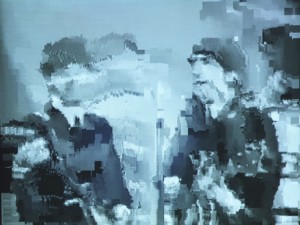« Reviews
Abstract Cinema and Technology

Cory Arcangel. Untitled (After Lucier), 2006. Unique digital work on Mini-Mac with projector. Variable Dimensions. Courtesy of Team Gallery, New York
Museum of Contemporary Art - North Miami
March 25 - May 10, 2009
By Bryan Barcena
Presented with the concept of an exhibition focusing on abstract cinema, one might expect a museum full of large black cubic theatres, projecting images akin to the kind you would find on your computer’s desktop screensaver; frigid mechanical op-art that would seem detached and departed from the human world. The exhibition, “Abstract Cinema and Technology,” curated by director Bonnie Clearwater at the Museum of Contemporary Art Miami has by and large managed to sidestep these conventions and has emerged as an exhibition replete with heart and soul.
The beauty of this well-spaced and artfully curated exhibition is in its ability to grasp viewers not through a mesmerizing meditation-like trance (although some of the exhibiting artists may be attempting to do so), but instead captivating through the charm, wit and whimsy of the film and video. Local artist Jen Stark’s Streaming Gradient surprises viewers by at first seeming completely abstract and flat, but upon closer inspection the concentric circles of bold color turn out to be made out of the paper cut-outs the artists is known for. Jennifer Steinkamp’s interactive video piece Smoke Screen utilizes some dual-projector magic to include viewers’ shadows in between the sparkling bands of light moving across the screen.
Perhaps the most surprising aspect of “Abstract Cinema and Technology” is how far back into the twentieth century it reaches to highlight the work of some of the first experimental filmmakers. Hans Richter’s delightful suprematist film Rhythmus 21, dating back to 1921, fascinates with its ability to give dynamism and life to pulsating monochromatic squares. Mary Ellen Butte’s composition combines Technicolor hand-drawn abstract images together to create a lively film complemented by Edvard Grieg’s Latin jazz arrangement Anitra’s Dance.
The blue chip names in 20th century video art are also present in the exhibition; a witty video by Bruce Nauman entitled Lip Synch shows a macro view of the artist’s mouth repeating the phrase ‘lip synch’ as the audio slowly falls out of synch with the video. Two works by pioneering video artist Nam Jun Paik, one a robotic sculptural installation including various screens, the other a subtle video manipulating images of The Beatles, fail to captivate when set amongst the work of the other more contemporary artists who seem to whiz and bang comparatively.
The work created by these contemporary artists illustrates the large role that new technology has and continues to play in the production of abstract cinema. Cory Arcangel’s piece Untitled (After Lucier) uses computer software to create a continuously degrading loop of The Beatles’ 1964 performance on the Ed Sullivan Show; eventually the black and white video breaks down into pure monochrome abstraction. Artists Jiae Hwang and Nicolas Raftis III’s Metastability Mirror uses a small camera to capture viewers’ movements allowing participants to manipulate the video’s series of ominous sounds while a screen responds to the actions though the sporadic movements of a geometric polygon.
“Abstract Cinema and Technology” at the Museum of Contemporary Art Miami is an exhibition that breaks free from a kind of cold sterility attributed to abstract cinema, providing an environment where viewers can enjoy film that is both entertaining and innovative.
Bryan Barcena is a graduate of the University of Michigan specializing in Art History and Latin American Studies. He is the Assistant Director of Chelsea Galleria Wynwood, in Miami.
Filed Under: Reviews


































